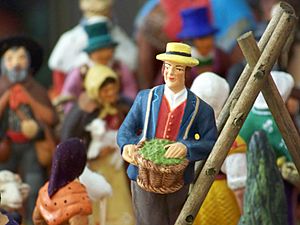Santon (figurine) facts for kids
A santon is a special kind of small, hand-painted figurine. These tiny statues are usually made from terracotta, which is a type of baked clay. People use santons to create beautiful nativity scenes, especially around Christmas time.
Santons are a very old tradition from the Provence region in southeastern France. The word "santon" actually means "little saint" in the local Provençal language. The person who makes these charming figures is called a santonnier.
The Story of Santons
Santons became very popular during a big historical event called the French Revolution. This was a time in France (around the late 1700s) when there were many changes in the country's government and society. During this period, churches were sometimes closed, and large nativity scenes, which were usually found in churches, were not allowed.
Because people still wanted to celebrate Christmas and create nativity scenes, they started making smaller figures they could keep in their homes. These little santons quickly became a beloved tradition. They allowed families to continue their customs even when big public celebrations were not possible.
Where Santons Are Made
The main places where santons are traditionally made are cities like Marseille, Aix-en-Provence, Arles, and Aubagne. These cities are all located in the beautiful Provence region of France.
As Christmas gets closer, usually in the month before, special santon fairs are held all over Provence. At these fairs, you can find santons of all different sizes. People visit these fairs to buy new figures to add to their home nativity scenes, also known as creches. It's a fun way to get ready for the holidays and celebrate a unique part of French culture.
Different Kinds of Santons
While many santons show the traditional figures and animals from the nativity story, like shepherds, angels, and even camels or elephants, there are many other types too! Santon makers also create figures that show everyday life in a Provençal village.
You can find santons of all sorts of characters, such as a baker, a fisherman, a farmer, or even a musician. Some popular figures include the "motley fool," a miller, or a blind man. Another common santon is a shepherd holding his hat, with his cloak blowing in the wind. This figure represents the strong winds, like the mistral, that blow through Provence. These figures help tell the story of the village and its people, making each nativity scene unique and lively.



